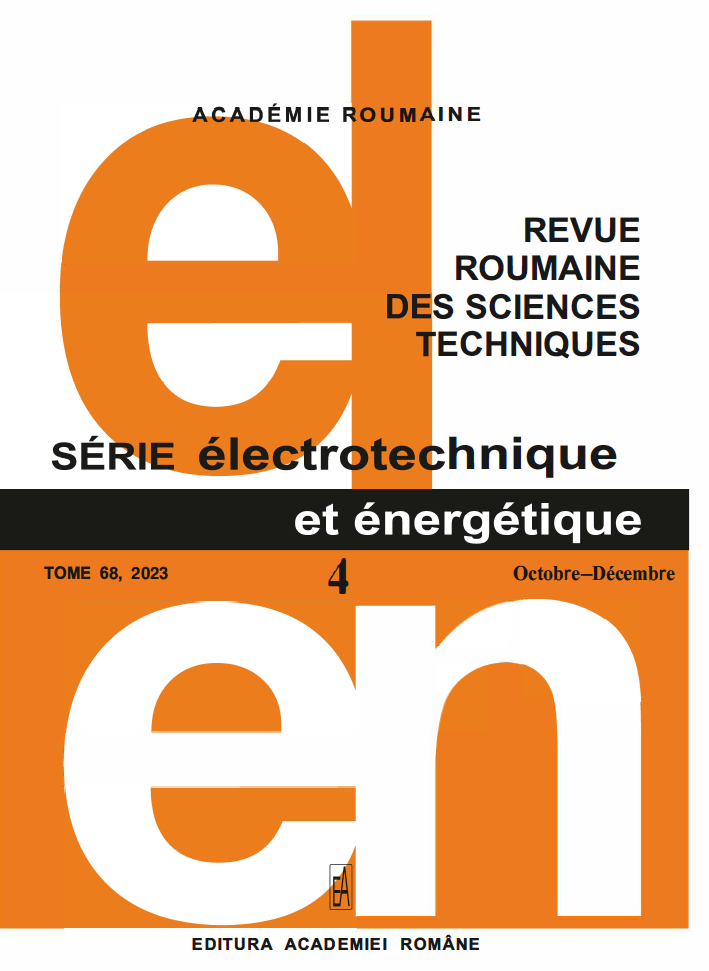THE DESIGN OF THE POWER SUPPLY CURRENT LEADS TO A HIGH-TEMPERATURE SUPERCONDUCTING ELECTROMAGNET
DOI:
https://doi.org/10.59277/RRST-EE.2023.4.18Keywords:
Current leads, Design, Numerical modeling, Superconducting electromagnet, Low temperatures, Heat loadAbstract
The paper presents a theoretical and experimental analysis of thermal conditions imposed on the power supply conductor for an HTS YBCO-type high magnetic field electromagnet. For thermal stability during the operation of the electromagnet, it is essential to lower the heat flux from outside the system. The heat from the surrounding environment to the HTS winding is limited by using an adequately sized cryogenic system and the proper design of the current leads. The HTS winding and current leads are cooled with a two-stage GM cryocooler. If the power supply conductor's conductive heat flux exceeds the cryocooler’s heat load, the temperature of the HTS winding will increase, and system instability may occur. The power supply conductors are of two types: copper conductors and mixed HTS conductors. This work analyzes HTS conductors and junctions of HTS tape with copper terminals and their contribution to the cryocooler’s total heat load. Using HTS conductors reduces Joule heat when current passes through them (approx. 300 A) and the conductive heat flux to the HTS windings. Resistance for various soldering alloys was experimentally evaluated to evaluate the Joule heat of the junctions between HTS conductors and copper terminals.
References
(1) R. Radebaugh, Refrigeration for superconductors, Cryogenic Technologies Group, National Institute of Standards and Technology, Boulder, CO 80305 USA: Proc. of the IEEE, 92, 10 (Oct. 2004).
(2) R. Radebaugh, Review of refrigeration methods, https://trc.nist.gov/
cryogenics/Papers/Review/2020-Review_of_Refrigeration_
Methods.pdf
(3) H. Maeda, Y. Yanagisawa, Future prospects for NMR magnets: a perspective, Journal of Magnetic Resonance, 306, pp. 80–85 (2019).
(4) P Schmuser, Superconducting magnets for particle accelerators, Rep. Prog. Phys. 54, 683 (1991).
(5) L. Rossi, L. Bottura, Superconducting magnets for particle accelerators, Reviews of Accelerator Science and Technology, 5, pp. 51–89 (2012).
(6) I. Dobrin et al., High-temperature superconductor dipolar magnet for high magnetic field generation - design and fabrication elements, 10th International Symposium on Advanced Topics in Electrical Engineering (ATEE), Bucharest, Romania, pp. 201–205 (2017).
(7) M. Daibo, S. Fujita, M. Haraguchi, Y. Iijima, M. Itoh and T. Saitoh, Development of a 5T 2G HTS magnet with a 20-cm-diameter Bore, in IEEE Transactions on Applied Superconductivity, 23, 3, pp. 4602004 – 4602004, Art no. 4602004 (June 2013),.
(8) I. Dobrin, A.M. Morega, A. Nedelcu, M. Morega, Design and fabrication of a 5 T NbTi solenoid magnet cooled by a closed-cycle
G-M cryocooler, International Symposium on Advanced Topics in Electrical Engineering (ATEE), Bucharest, Romania, pp. 1–4, (2013).
(9) C.K. Yang et al., Design, Fabrication, and Performance Tests of a HTS Superconducting Dipole Magnet, in IEEE Transactions on Applied Superconductivity, 22, 3, pp. 4000804 – 4000804, June (2012).
(10) H.W. Weijers et al., High field magnets with HTS conductors, in IEEE Transactions on Applied Superconductivity, 20, 3, pp. 576–582, June (2010).
(11) I. Dobrin, A. Cernikov, S. Kulikov, A. Buzdavin, O. Culicov, A.M. Morega, A. Nedelcu, M. Morega, I. Popovici, A. Dobrin, A 4 T HTS magnetic field generator, conduction-cooled, for neutron physics spectrometry, IEEE Transactions on Applied Superconductivity, 26, 3, April (2016).
(12) G. Dumitru, A. Morega, I. Dobrin, D. Enache, A. Nedelcu, Analysis of the thermal and electrical parameters of the supply system of an HTS superconducting electromagnet, International Conference and Exposition on Electrical and Power Engineering (EPE), (2022).
(13) ***SHI Cryogenics Group, https://www.shicryogenics.com/products/
cryocoolers/
(14) G. Dumitru, I. Dobrin, D. Enache, Design of a HTS superconducting electromagnet for intense and uniform high magnetic field (translated from Romanian), APME — Electric Machines, Materials and Drives – Present and Trends, 18, 1, pp. 125–135, (2022).
(15) G. Dumitru, A. Morega, I. Dobrin, D. Enache, A. Dobre, C. Dumitru, Thermal influence of a variable temperature insert on the high-temperature superconductor coils of a conduction cooled high magnetic field generator, The 13th International Symposium on Advanced Topics in Electrical Engineering March 23–25, Bucharest, Romania (2023).
(16) ***Superpower Inc., https://www.superpower-inc.com/specification.aspx.
(17) D. Marian, M. Eva, P. Marcela, P. Marian, F. Lubomir, G. Peter, J. Igor, M. Jozef și G. Fedor, Induction soldering of coated conductor high-temperature superconducting tapes with lead-free solder alloys, IEEE Transactions on Applied Superconductivity, 28, 4 (June 2018).
(18) J.S. Murtomäki, G. Kirby, J. Van Nugteren, P.-A. Contat, O.S. De Frutos, J. Fleiter, F.-O. Pincot, G. de Rijk, L. Rossi, J. Ruuskanen, A. Stenvall și F.J. Wolf, 10 kA joints for multi-tape HTS Cables, Magnet Technology, Amsterdam, N. (2017).
(19) M. Bonura, C. Senatore, Transverse thermal conductivity of REBCO coated conductors, IEEE Transactions on Applied Superconductivity, 25, 3 (June 2015).
(20) N. Bagrets, W. Goldacher, S. I. Schlachter, C. Barth, Klaus-Peter Weiss, Thermal properties of 2G coated conductor cable materials, Cryogenics, 61, pp. 8–14 (2014).
(21) Y. Iwasa, Case Studies in Superconducting Magnets: Design and Operational Issues, Springer Science + Business Media, LLC (2009).
Downloads
Published
Issue
Section
License
Copyright (c) 2023 REVUE ROUMAINE DES SCIENCES TECHNIQUES — SÉRIE ÉLECTROTECHNIQUE ET ÉNERGÉTIQUE

This work is licensed under a Creative Commons Attribution-NonCommercial-NoDerivatives 4.0 International License.


